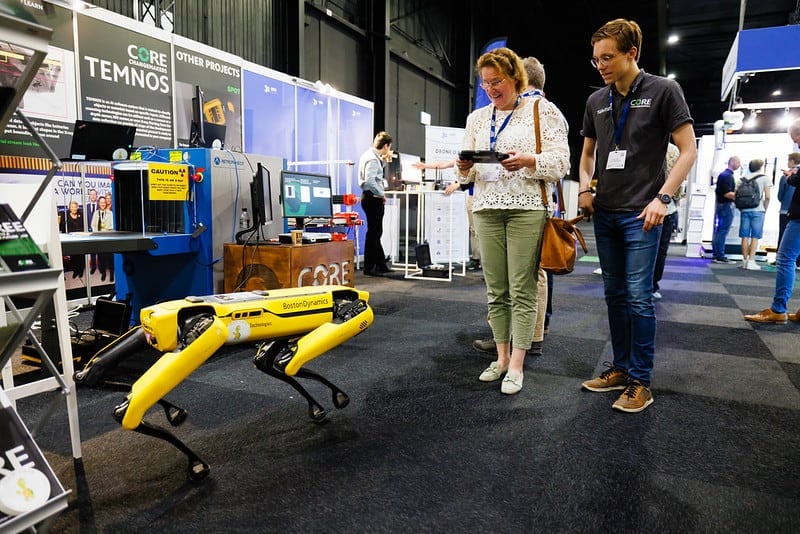
Robots mowing lawns is a form of robotic assistance to which society has gotten used. But there are currently few concepts for robotic assistance in other tasks, which involve close proximity to humans, like housekeeping and care.
The Fraunhofer Institute for Machine Tools and Forming Technology IWU uses innovative switchable stiffnesses in robots to combine the required strength with the necessary safety. At the Hannover Messe Preview on March 16, 2022 and at the Hannover Messe from May 30 to June 2, 2022, The researchers will be presenting a robot arm that could facilitate the support of people in their direct surroundings, says Fraunhofer in a press release.
How about parents having time to sit comfortably on the couch in the evenings and read to their kids while the robot cleans up in the kitchen? Or caregivers once again having time to focus on the human and emotional aspects of their jobs while a robot deals with the hard, monotonous parts? Until now, scenarios like these have been ideas of science-fictional stories. After all, robots are mainly used in industry in the form of stiff robot systems that are streamlined for force and precision, and that require very complex safety plans to ensure that no workers are put at risk.
Humanoid appearances? Not exactly…
The goal that researchers at Fraunhofer IWU have set themselves is to drive robotics forward in areas involving close proximity to humans. “Robots for use in close proximity to humans generate very different requirements from those used in industry, where workers can be trained in a specific way,” says Linda Weisheit, Topic manager for the
field “Robotics for Humans” at Fraunhofer IWU. “If robots are going to be used in everyday life, first of all they need to be safe and second of all, they must have an appropriate appearance that increases acceptance.” While humanoid robots are desirable in Japan, Europeans tend to find similarities to humans disconcerting. The researchers are
therefore keeping a steady eye on the design side.
Switchable stiffness provides force and safety
Soft robotics provides a good basis when it comes to safety: It makes use of soft materials that cannot cause injuries. On the other hand, these robots are not able to perform quite as many tasks – even a full cup of coffee would be too heavy for a soft robot arm. “We are therefore working on developing new structures with switchable stiffness – meaning they can switch between stiff and soft,” Weisheit explains. The principle behind this switchable stiffness is similar to that used in coffee packaging: When vacuum-packed, it is hard and solid, but if air gets in, then it becomes nice and soft. In order to increase structural stiffness further, particularly under tensile strain, the team of researchers is combining it with films placed on top of each other. The result of this combination is that the system can withstand tensile strain as well as be resistant to compression.
Using these kinds of structural components with switchable stiffness makes it possible to design new movement concepts and new safety systems. What this could mean for our day-to-day lives is best explained using an example like the filled cup of coffee. If the robot needs to pick it up, it makes its soft arm a little stiffer so that it can apply the necessary force. In its solid state it is 300 times stiffer than when it is soft; in other words, it has a switch factor of 300. However, if a collision is imminent – for example, if a human gets too close – the mechanical assistant will not simply switch back to its soft state. That would cause it to drop the cup onto the floor, leaving a pool of scalding hot coffee that might pose a risk to a small child. Instead, it is designed to execute an evasive movement. In other words: Like a human, it gets out of the way of the obstacle while still holding the cup.
Robot arm at the Hannover Messe
The researchers have already taken the first step towards the overall robot system and have provided an initial idea as to what the overall system could look like. They have developed the relevant structural components, combined them with sensors and actuators as well as gesture control, and produced a tendon-driven robot arm that consists of three switchable segments and executes planar movements via gesture control. The team of researchers will be presenting this robot arm at the Hannover Messe Preview on March 16, 2022 and at the Hannover Messe from May 30 to June 2, 2022. “We want to start a dialog with users early on and find out what their specific needs are,” Weisheit explains. This will allow the researchers to continue their developments in line with user needs.
Also interesting: Underground robotics improve geomonitoring
Selected for you!
Innovation Origins is the European platform for innovation news. In addition to the many reports from our own editors in 15 European countries, we select the most important press releases from reliable sources. This way you can stay up to date on what is happening in the world of innovation. Are you or do you know an organization that should not be missing from our list of selected sources? Then report to our editorial team.






